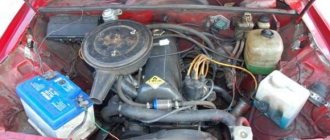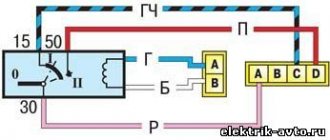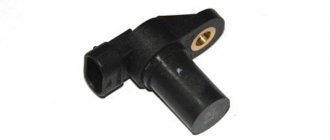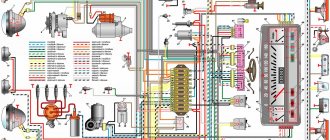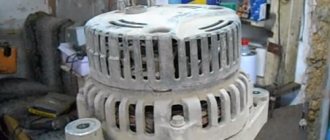The VAZ-2103, which is still driving around the Russian expanses, is today at a fairly advanced age, by automotive standards. Accordingly, their owners are increasingly faced with the need for repairs, including the engine. According to the manufacturer’s recommendation, the resource of this engine is 125 thousand kilometers. In practice, the Troika’s power units were looked after much more, of course, subject to careful treatment, as well as competent and timely maintenance.
What engines was equipped with the VAZ 2103
The VAZ 2103 power plant is a classic model, part of the AvtoVAZ OJSC engine line. This is a modernized version of the FIAT-124 unit, developed by domestic engineers back in the second half of the last century. The changes affected the camshaft and the inter-cylinder distance.
The tuning of the FIAT-124 engine was carried out with high quality, because in the future its mass production did not stop for decades. Of course, restylings were carried out, but the core of the engine remained the same. The peculiarity of the VAZ 2103 engine is that its timing shaft is driven by a chain and not a belt.
The 1.5-liter power unit represents the third of four generations of the classic. This is the heir to the 1.2 liter VAZ 2101 and 1.3 liter VAZ 21011 engines. It preceded the creation of the powerful 1.6 liter VAZ 2106 unit and more modern injection engines for front-wheel drive cars. All modifications of the VAZ 2103 engine were distinguished by improved technical capabilities.
VAZ 2103 appeared in 1972 and became the first four-eyed Zhiguli model. Maybe this was the reason for equipping the car with a new and powerful unit that develops 71 hp. With. It was rightly called the most “survivable” engine of its time - even a mileage of 250 thousand km did not have a detrimental effect on it if the driver adhered to the factory rules of operation and maintenance. The usual service life of this engine was 125 thousand kilometers.
The 1.5-liter power unit represents the third of four generations of the classic
The improved performance of the VAZ 2103 power unit is immediately noticeable in the design features. The engine is equipped with a different cylinder block - as much as 215.9 mm instead of 207.1 mm. This made it possible to increase the working volume to 1.5 liters and install a crankshaft with an increased piston stroke.
The camshaft is driven by a chain without a tensioner. It is not provided, and therefore the tension has to be checked and adjusted regularly.
More features.
- Valve clearances are subject to periodic adjustment, since the timing belt is not equipped with hydraulic compensators.
- The cylinder block is cast iron, the head is cast from an aluminum alloy.
- The camshaft is made of steel and has the peculiarity of 1 untreated journal with six edges.
- It is paired with either a carburetor with a VROZ (vacuum ignition regulator) or an injection system, but with a corresponding timing belt - the design of the cylinder head has been changed.
- The lubrication pump is located in the engine crankcase.
The technical capabilities of the engine are as follows:
- the cylinder diameter was returned to 76 mm;
- The piston stroke was increased by 14 mm;
- Engine volume in cubic centimeters became equal to 1452 cubic meters. cm;
- two valves work with each cylinder;
- the engine is powered by gasoline with an octane rating of AI-92 and higher;
- The oil used is within the range of 5W-30/15W-40, its consumption is 700g/1000 km.
It is interesting that the subsequent VAZ 2106 engine received cylinders with a diameter increased to 79 mm.
Pistons
The internal combustion engine elements of the VAZ 2103 are made of aluminum and are oval in cross-section. The size of the piston at the top is smaller than at the bottom. This explains the peculiarity of the measurement - it is carried out only in a plane that is perpendicular to the piston pin and located at a distance of 52.4 mm from the bottom.
According to the outer diameter, VAZ 2103 pistons are classified into 5, every 0.01 mm. They are divided into 3 categories every 0.004 mm according to the diameter of the hole for the finger. All data on piston diameters can be viewed on the lower part of the element - the bottom.
For the VAZ 2103 power unit, a piston type with a diameter of 76 mm without a recess is suitable . But for VAZ 2106 and 21011 engines this figure is 79, the piston has a recess.
Piston with a diameter of 76 mm without recess for the VAZ 2103 power unit
Crankshaft
The VAZ 2103 crankshaft is made of super-strong material and has nine journals. All necks are thoroughly hardened to a depth of 2–3 mm. The crankshaft has a special seat for installing the bearing.
The neck joints are channelized. They carry oil for the bearings. The channels are plugged with caps pressed for reliability at three points.
The crankshaft of the VAZ 2103 is similar to the VAZ 2106, but differs from the internal combustion engine units of the “kopek” and the eleventh model in the size of the crank. The latter is increased by 7 mm.
Dimensions of half rings and journals of the crankshaft.
- The half rings have a thickness of 2.31–2.36 and 2.437–2.487 mm.
- Molar necks: 50.545–0.02; 50.295–0.01; 49.795–0.002 mm.
- Crankpins: 47.584–0.02; 47.334–0.02; 47.084–0.02; 46.834–0.02 mm.
Flywheel
The part is cast iron with a steel ring gear that is connected to the starter gear. Pressing of the crown is done using the hot method. The teeth are thoroughly hardened by high frequency currents.
The flywheel is secured using 6 self-locking bolts. The location of the clamps has only two positions according to the marks. Centering of the flywheel with the crankshaft is carried out through the front bearing of the gearbox drive shaft.
Table: main technical characteristics.
| Engine capacity | 1450 cm3 |
| Power | 75 hp |
| Torque | 104/3400 nm |
| Gas distribution mechanism | HE IS WITH |
| Number of cylinders | 4 |
| Number of valves per cylinder | 2 |
| Cylinder diameter | 76 mm |
| Piston stroke | 80 mm |
| Compression ratio | 8.5 |
Design Features
Engine Toyota 2NZ-FE
Initially, at the design stage, a feature for the engine was the overhead camshaft:
- The piston stroke decreased by 5.5 mm compared to the Fiat 124 standard;
- the cylinder diameter increased by 3 mm.
This modernization ensured acceleration and rapid acceleration. In addition, the 2101 engine had the following design nuances:
- timing chain transmission;
- unfinished carburetor models;
- major overhaul after 20,000 km.
Valve train chain
Immediately after the release of the first internal combustion engine of this series, the manufacturer AvtoVAZ released a manual in which it indicated which oil to fill in the engine and provided a description of the internal combustion engine parameters to increase the service life of the engines. Thus, the owners of the next three generations of engines had no questions about what oil to pour and in what quantity.
Timing mechanism
What engine can be installed on a VAZ 2103 instead of the standard one?
Domestic cars are good because with a sufficient budget it will be possible to implement almost any planned project. Even when connecting the engine to the gearbox there are no particular difficulties. Thus, almost any power unit is suitable for the VAZ 2103. The main thing is that it must fit in size.
Rotary engine
Until a certain time, only special police forces and the KGB were armed with cars with such engines. However, tuning enthusiasts in the USSR, folk craftsmen, found and installed a rotary piston engine (RPE) on their VAZ 2103.
The RPD can be easily installed on any VAZ car. It goes to Moskvich and Volga in a three-section version.
The rotary piston engine can be easily installed on any VAZ car
Diesel engine
The diesel engine is mated to the standard VAZ 2103 gearbox using an adapter plate, although the gear ratios of the engines are not at all suitable.
- Driving with a diesel Volkswagen Jetta Mk3 will not be very comfortable, especially after 70–80 km/h.
- The option with a diesel unit from the Ford Sierra is a little better. In this case, you will have to change the design of the tunnel, install a gearbox from a BMW and make some other changes.
Motors from foreign cars
In general, foreign-made engines have been and are often installed on the VAZ 2103. True, it is impossible to avoid additional modifications in this case.
- The most popular engine is the Fiat Argenta 2.0i. About half of the owners of tuned “threes” installed these engines. There are practically no problems with installation, however, the engine is a bit old, which is unlikely to please the owner.
- Engines from BMW M10, M20 or M40 are also suitable. We have to modify the struts, rework the flywheel and replace the axles.
- Engines from Renault Logan and Mitsubishi Galant are praised by craftsmen, but in these cases the gearbox has to be changed.
- And, probably, the best option is the power plant from Volkswagen 2.0i 2E. True, such an engine is not cheap.
Recommendations
Do not forget that high speed is very destructive for a VAZ engine.
Overheating and overloading of the unit can lead to serious damage to parts, after which many structural elements will have to be replaced. You should not push the maximum on the track without installing special parts, otherwise the engine will turn into a cauldron of fire.
If you do not want to frequently repair your VAZ engine, replace worn parts with similar ones. If you install more powerful spare parts, the structure may simply not hold up.
The only option to increase the performance of such weak engines is to install additional parts. In the case of Zhiguli, a good option for increasing power would be to install new pistons and cylinder head, as well as update the exhaust system elements. To do this, you will need to bore the cylinders to 79-82 mm. Other tuning options
Servicing VAZ engines is not difficult if you need to replace parts at home. If you have instructions, you can dismantle and replace almost any element of the engine assembly. But if you are not sure of the cause of the breakdown, it is better to visit a service station, where a technician can identify and fix the problem.
We recommend: How to replace brake discs on a Lada Priora yourself?
VAZ 2103 engine malfunctions
The most common defects found on the engine:
- large “gorge” of oil;
- difficult launch;
- floating speed or stopping at idle speed.
All these malfunctions are associated with various reasons, which will be discussed below.
The engine gets very hot
Experts call the main reason for overheating of the engine unit a lack of refrigerant in the system. According to the rules, before leaving the garage, the driver is required to check the level of all technical fluids each time. But not everyone does this, and then they are surprised to find themselves with a “boiling” internal combustion engine on the side of the road.
Engine overheating occurs due to a lack of refrigerant in the system
Antifreeze may leak from the system. In this case, there is a malfunction - a violation of the integrity of the cooling system. Antifreeze stains on the floor of the garage in which the car was parked directly indicate to the owner that there is a leak. It is important to eliminate it in a timely manner, otherwise there will not be a drop of liquid left in the tank and system.
The reasons for the leak are as follows.
- Most often, refrigerant leaks are caused by hose clamps that are not tightened tightly enough. The situation is especially bad if the clamp is iron and it cuts the rubber pipe. In this case, you have to change the entire segment of communication.
- It also happens that the radiator begins to leak. In such a situation, it makes more sense to replace the element, although small cracks can be repaired.
- Antifreeze leaks through the gasket. This is the most dangerous situation, since the liquid will go inside the engine, and the car owner will not notice any leaks. It will be possible to determine the “internal hemorrhage” of the system only by an increase in refrigerant consumption and a change in its color to “coffee with milk”.
Another reason for engine overheating is a non-working radiator fan. On a VAZ 2103, the quality of cooling by the engine blades is extremely important. The slightest sagging of the drive belt has a negative effect on it. But this is not the only reason for the element to be released.
- The fan can simply deteriorate and burn out.
- The fuse responsible for the electrical circuit fails.
- The contacts on the fan terminals are oxidizing.
Finally, overheating of the internal combustion engine can occur due to damage to the thermostat.
Engine knock
On a VAZ 2103, engine knock is detected without special equipment, by ear. A 1-meter wooden pole is taken and one end is applied to the motor in the part being tested. The other side of the pole should be clenched in your fist and brought to your ear. It turns out something like a stethoscope.
- If a knock is heard in the area of the connector with the oil sump, it is dull, and the frequency depends on the amplitude of rotation of the crankshaft - this is the knocking noise from the worn-out crankshaft main bearings.
- If the sound is heard above the crankcase connector, it intensifies as the engine speed increases - this is the connecting rod bearings knocking. The noise will become louder as the spark plugs are disconnected one at a time.
- If the sound comes from the cylinder area and is best heard at low engine speeds, as well as under load, it is the pistons knocking on the cylinder.
- A knocking sound in the head area when you sharply press the accelerator pedal indicates worn piston seats.
VAZ 2103 engine smokes
As a rule, at the same time as the smoke, the engine eats up oil. It may be gray in color and increase with increasing idle speed. The reason is related to the oil scraper rings that require replacement. It is also possible that one of the candles is not working.
In some cases, this happens due to a ruptured gasket or insufficient tightening of the head bolts. On older engines, there may be a crack in the block head.
Troubles the engine
The phrase “troubling engine” means that one or more cylinders are not working. The power plant is not capable of developing full power and does not have the required traction force - accordingly, fuel consumption increases.
The main causes of tripping are: faulty spark plugs, incorrectly set ignition timing, loss of tightness in the intake manifold area, etc.
Engine misfire is caused by incorrectly set ignition timing.
Long-term operation
Maintenance is very important for the VAZ model 2103. Timely replacement of oil, spark plugs, fuel and parts significantly extends the operating life of the engine, so serious repairs in such conditions are practically not needed.
Much attention should be paid to the selection of oil. Since mechanical wear of most parts is the main problem that promises early engine failure, you need to choose a good technical fluid with an optimal set of additives. When changing the oil, it is advisable to also replace the oil filter. The amount of fluid when replacing should be 3.5 liters out of 3.75 liters. In addition to mechanical wear, using high-quality oil will also prevent corrosion damage to parts.
Don't forget to change the air filter as well. Both filters should be replaced and checked regularly.
If frequent VAZ engine repairs are not part of your plans, pay attention to the condition of other elements. Replacing sensors, timing belts and spark plugs allows you to maintain the good condition of the entire assembly.
In cases where the engine starts to stall, try changing the brand of gasoline.
Cold method of pressing a finger into a VAZ connecting rod. Video
The crankshaft has been installed, now we need to knock out the old pistons and install new repair pistons on the connecting rods. It is good to knock out the piston pins on a stump; drill a hole in the stump in advance, or knock it out with a chisel; the piston pin will be knocked out into this hole. It is advisable to knock out the finger with a special beard, or a round piece preferably with a diameter of 21 mm, and a heavy hammer. The piston pins are knocked out when cold; there is no need to heat them up.
Photo. Preparing pistons for installation on connecting rods.
Now we need to install new pistons on the connecting rods, you can install the pistons as is without modification, but I advise you not to be lazy and modify the pistons. First, chamfer the skirt using a sharpener or a file as shown in the photo, second, drill a hole in the piston skirt on both sides as shown in the photo.
Engines with modified pistons are much faster and more economical, since oil flows through the hole between the piston and cylinder skirt and reduces friction. Also, modified pistons do not suffer much if the engine accidentally overheats. The hole in the piston skirt used to be drilled 6mm, now it’s 14mm, so with a 14mm hole the engine turns out even faster.
Photo. A piston with a connecting rod, arrow 1 shows the front of the piston (letter P), arrow 2 shows the liner locks.
The photo shows how the piston should be positioned correctly on the connecting rod. You can drive your finger into the connecting rod while it’s hot, but here you don’t need to heat the connecting rod too much; it’s enough to heat it even in water to boiling water. Also, when the connecting rod is heated, you need to hammer in the piston pin very quickly, since if you hesitate a little, the pin will immediately take over the heating of the connecting rod and will become difficult to clog. I hammer it on a cold one, also on a stump, but I put a piece of a wooden block under the piston in the area of the piston pin, lubricate the pin and the hole in the connecting rod with oil, and also hammer the pin into the connecting rod with a heavy hammer. After hammering in the finger, be sure to check so that the finger is positioned exactly in the center and does not come out of the piston under any circumstances.
Ignition installation
After the valve adjustment is completed, we begin to set the ignition. Oil may leak out from under the distributor; to prevent this from happening, sealant must be applied under the distributor. The ignition is set to the fourth cylinder, the crankshaft pulley must be placed on the first mark of the cover, the mark of the camshaft sprocket should be at the very top, in the fourth cylinder this is the compression stroke, insert the distributor into the engine so that the slider faces the fourth cylinder towards the wire exit. Now we turn the distributor clockwise, as soon as the contact opens, the distributor can be tightened, all ignition is set. Now all that remains is to connect the sensors, install the valve covers, as well as the choke cable, throttle levers, and fill in antifreeze.
Adjustment of valves
You need to start adjusting the valves from the fourth cylinder, the mark on the camshaft sprocket should be opposite the camshaft mark, so we will adjust the 8th and 6th valves, then turn the crankshaft 180 degrees, then we can adjust the 4th and 7th valves, turn the crankshaft another 180 degrees 1 and 3, to adjust 5 and 4, turn another 180 degrees.
You can buy a feeler gauge designed for adjusting valves, this feeler gauge needs to be inserted between the camshaft and the rocker, loosen the nut by seventeen, and with a wrench of 13 you need to move the rocker so that it slightly clamps the feeler gauge. Now we slightly tighten the nut to seventeen, and with a wrench to 13 we loosen the rocker until the feeler gauge moves not hard but not easily, and now we tighten the nut to seventeen, if the feeler gauge tightens, the adjustment must be repeated. In my opinion, you don’t need to adjust the valves well right away, the point is that when you start the engine, it will run for a couple of minutes, the valves will clearly sit in their places, and you will have to adjust them again.



